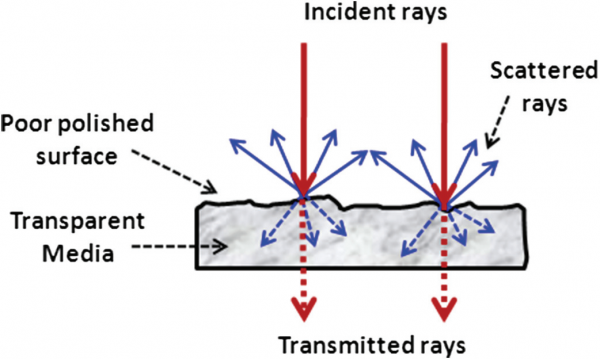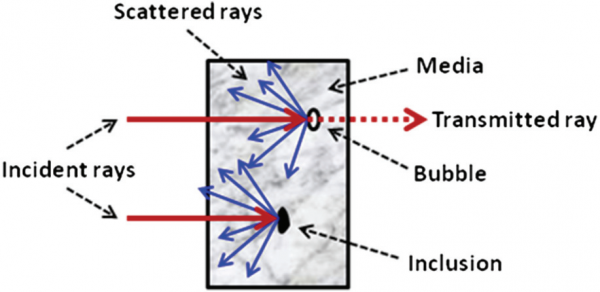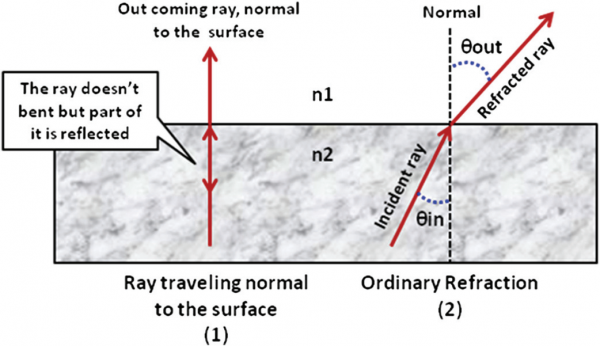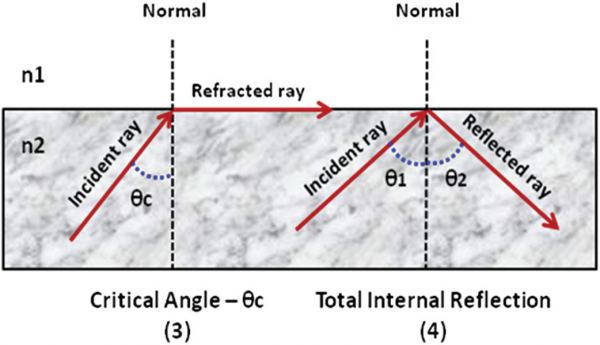What is Geometrical Optics?
Geometrical optics, or ray optics, describes light behavior in terms of “rays,” which is an abstracted description for the behavior of light when it travels in a homogeneous medium, bends or splits in two at an interface between two dissimilar media, and then is reflected, refracted or absorbed. The light ray is perpendicular to the light’s wavefronts (and is therefore collinear with the wave vector).

The main characteristics that refer to the geometrical optics are reflection, refraction, and dispersion, as well as two other factors:
• scattering, and
• critical angle and total internal reflection.
Scattering
The scattering of light (an electromagnetic radiation) means that when light impinges on or passes through a medium that is not uniform (fully or localized), it scatters in all directions. Theoretically, a perfect mirror’s surface or 100% homogenous optical material (without bubbles or inclusions and with a perfectly polished surface) will reflect or transmit light, respectively, perfectly without scattering; however, in the real world, there is always some kind of inhomogeneity that creates scattering.
Scattered light from or in an optical element or assembly mostly affects the following optical characteristics:
• Transmission of the optical element (more scattering means less
transmission), and
• Reflection from exposed (not blackened) surfaces in optical assemblies might confuse the image or the wavefront.
Reducing the scattering is made by the optical engineering by determining the polishing surface quality (by scratch–dig and roughness requirements) and raw material quality, or purity (by bubbles and inclusions class). Thus, the scattering may occur mainly out of the following reasons: a poor polish surface or bubbles and inclusions. Furthermore, the finished optical surfaces of the optical elements must be cleaned during each step of production and assembly in order to eliminate the scattering from different kinds of particles attached to the optical surfaces.


Critical angle and total internal reflection
When a light ray passes from one transparent medium to another, there are four possibilities for the light ray behavior:
- The light ray is traveling normal to the surface, and it is not bent when passing from one medium to another, but part of it is reflected back. In glasses, each surface reflects about 4% of the incoming energy (light). See possibility (1) in Fig. below.
- In ordinary refraction, the incident light ray passing from media n2 in angle uin is reflected and comes out of medium n1 at angle uout.
See possibility (2) in Fig. below. - Critical angle: The minimum angle of incidence light ray beyond which total internal reflection occurs for light traveling from a medium with a higher refractive index n2 to a medium with a lower refractive index n1. In this case, the refracted light travels along the boundary between the two media and will not cross that boundary.
- Total internal reflection (TIR): A phenomenon that occurs when a light ray moving in a medium with a higher index of refraction n2 strikes the boundary of a medium with a lower index of refraction n1 at an angle that is greater than a particular critical angel. In such case, the entire light ray is reflected back to the original media. The incident ray θ1 is equal to the reflected ray θ2.


The critical angle can be calculated from Snell’s law;
![]()
and
![]()
If, for example, the critical angle of a light ray traveling from glass (nglass ≈ 1.5) to air (nair ¼ 1.0) is calculated, the critical angle will be

